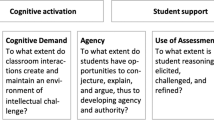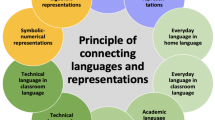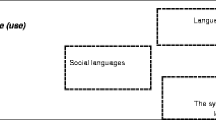Abstract
Practical instructional approaches are often criticized for focusing too exclusively on vocabulary work whereas research has revealed rich insights into the role of language on the discursive level. On the other hand, the mathematics education research community focusing on language has not yet filled the gap between research and classroom practices. In this paper, we present the theoretical frameworks which have grounded our attempts to fill this gap through topic-specific design research on fostering the competence of language learners. The frameworks are used for comparing two teaching–learning arrangements based on a macro-scaffolding and a relating registers approach, one focusing on discursive activation, the second with additional, integrated lexical support. The paper shows how the theoretical frameworks become visible in the design of the intended curriculum and the realized curriculum shaped by teachers’ micro-scaffolding moves.

Similar content being viewed by others
References
Aitchison, J. (2003). Words in the mind: An introduction to the mental lexicon (3rd edn.). Malden: Blackwell Publishing.
Bailey, A. L. (2007). Introduction: Teaching and assessing students learning English in school. In A. L. Bailey (Ed.), The language demands of school: Putting academic English to the test (pp. 1–26). New Haven: Yale University Press.
Bailey, A. L., Butler, F. A., Stevens, R., & Lord, C. (2007). Further specifying the language demands of school. In A. L. Bailey (Ed.), The language demands of school: Putting academic English to the test (pp. 103–156). New Haven: Yale University Press.
Bakker, A., Smit, J., & Wegerif, R. (2015). Scaffolding and dialogic teaching in mathematics education: Introduction and review. ZDM Mathematics Education, 47, 1047–1065.
Barwell, R. (2012). Discursive demands and equity in second language mathematics classroom. In B. Herbel-Eisenmann, J. Choppin, D. Wagner & D. Pimm (Eds.), Equity in discourse for mathematics education. Theories, practices, and politics (pp. 147–163). Dordrecht: Springer.
Beck, C., & Maier, H. (1994). Zu Methoden der Textinterpretation in der empirischen mathematikdidaktischen Forschung. In H. Maier & J. Voigt (Eds.), Verstehen und Verständigung im Mathematikunterricht—Arbeiten zur interpretativen Unterrichtsforschung (pp. 43–76). Köln: Aulis.
Clarkson, P. (2009). Mathematics teaching in Australian multilingual classrooms. In R. Barwell (Ed.), Multilingualism in mathematics classrooms—Global perspectives (pp. 145–160). Bristol: Multilingual Matters.
Cobb, P., & Bauersfeld, H. (1995). The emergence of mathematical meaning. Interaction in classroom cultures. Hillsdale: Lawrence Erlbaum.
Erath, K. (2017). Talking about conceptual knowledge. Case study on challenges for students with low language proficiency. In Proceedings of PME 41. Singapore: PME.
Erath, K. (2018). Creating space and supporting vulnerable learners. Teachers’ options for facilitating participation in oral explanations and the corresponding epistemic processes. In R. Hunter, M. Civil, B. Herbel-Eisenmann, N. Planas & D. Wagner (Eds.), Mathematical discourse that breaks barriers and creates space for marginalized learners (pp. 39–60). Rotterdam: Sense Publishers.
Erath, K., Prediger, S., Quasthoff, U., & Heller, V. Explaining to learn mathematics and learning to explain: Discourse competence as important part of academic language proficiency in mathematics classrooms (submitted).
Gee, J. (1996). An introduction to discourse analysis. Theory and method. New York: Routledge.
Gibbons, P. (2002). Scaffolding language, scaffolding learning. Teaching second language learners in the mainstream classroom. Portsmouth: Heinemann.
Grundler, E. (2009). Argumentieren lernen—die Bedeutung der Lexik. In M. Krelle (Ed.), Sprechen und Kommunizieren: Entwicklungsperspektiven, Diagnosemöglichkeiten und Lernszenarien in Deutschunterricht und Deutschdidaktik (pp. 82–98). Baltmannsweiler: Schneider-Verlag Hohengehren.
Haag, N., Heppt, B., Stanat, P., Kuhl, P., & Pant, H. A. (2013). Second language learners’ performance in mathematics: Disentangling the effects of academic language features. Learning and Instruction, 28, 24–34. https://doi.org/10.1016/j.learninstruc.2013.04.001.
Hammond, J., & Gibbons, P. (2005). Putting scaffolding to work: The contribution of scaffolding in articulating ESL education. Prospect, 20(1), 6–30.
Heller, V., & Morek, M. (2015). Academic discourse as situated practice: An introduction. Linguistics and Education, 28(31), 174–186. https://doi.org/10.1016/j.linged.2014.01.008.
Hunt, A., & Beglar, D. (2002). Current research and practice in teaching vocabulary. In J. C. Richards & W. A. Renandya (Eds.), Methodology in language teaching: An anthology of current practice (pp. 254–266). Cambridge: Cambridge University Press.
Jorgensen, R. (2011). Language, culture and learning mathematics: A Bourdieuian analysis of indigenous learning. In C. Wyatt-Smith, J. Elkins & S. Gunn (Eds.), Multiple perspectives on difficulties in learning literacy and numeracy (pp. 315–329). Dordrecht: Springer. https://doi.org/10.1007/978-1-4020-8864-3_15.
Krummheuer, G. (2011). Representation of the notion “learning-as-participation” in everyday situations of mathematics classes. ZDM - The International Journal on Mathematics Education, 43, 81–90.
Lesh, R., Post, T., & Behr, M. (1987). Representation and translations among representations in mathematics learning and problem solving. In C. Janvier (Ed.), Problems of representation in the teaching and learning of mathematics (pp. 33–40). Hillsdale: Lawrence Erlbaum Associates.
Maier, H., & Schweiger, F. (1999). Mathematik und Sprache. Zum Verstehen und Verwenden von Fachsprache im Unterricht. Wien: öbv & hpt.
Margolinas, C. (2013). Task design in mathematics education. In Proceedings of ICMI study 22. <hal-00834054v2>.
Morgan, C., Craig, T., Schütte, M., & Wagner, D. (2014). Language and communication in mathematics education: An overview of research in the field. ZDM - The International Journal on Mathematics Education, 46(6), 843–853.
Moschkovich, J. (2002). A situated and sociocultural perspective on bilingual mathematics learners. Mathematical Thinking and Learning, 4(2, 3), 189–212.
Moschkovich, J. (2013). Principles and guidelines for equitable mathematics teaching practices and materials for English language learners. Journal of Urban Mathematics Education, 6(1), 45–57.
Moschkovich, J. (2015). Academic literacy in mathematics for English learners. Journal of Mathematical Behavior, 40, 43–62.
Orton, A. (1987). Learning mathematics: Issues, theory, and classroom practice. London: Cassell Education.
Pimm, D. (1987). Speaking mathematically: Communication in mathematics classrooms. London: Routledge.
Planas, N. (2018). Language as resource: A key notion for understanding the complexity of mathematics learning. Educational Studies in Mathematics, 98(3), 215–229. https://doi.org/10.1007/s10649-018-9810-y.
Planas, N., Morgan, C., & Schütte, M. (2018). Mathematics education and language: Lessons and directions from two decades of research. In T. Dreyfus, M. Artigue, D. Potari, S. Prediger & K. Ruthven (Eds.), Developing research in mathematics education. Twenty years of communication, cooperation and collaboration in Europe. London: Routledge.
Prediger, S. (2013). Focusing structural relations in the bar board: A design research study for fostering all students’ conceptual understanding of fractions. In B. Ubuz, C. Haser & M. A. Mariotti (Eds.). Proceedings of the 8th congress of the European Society for Research in Mathematics Education (CERME 8 in Antalya 2013) (pp. 343–352). Ankara: METU University.
Prediger, S., & Pöhler, B. (2015). The interplay of micro- and macro-scaffolding: An empirical reconstruction for the case of an intervention on percentages. ZDM Mathematics Education, 47, 1179–1194.
Prediger, S., & Wessel, L. (2013). Fostering German language learners’ constructions of meanings for fractions: Design and effects of a language- and mathematics-integrated intervention. Mathematics Education Research Journal, 25(3), 435–456.
Quasthoff, U. (2012). Globale und lokale Praktiken in unterschiedlichen diskursiven Genre. Wie lösen L2-Sprecher globale Anforderungen bei eingeschränkter sprachstruktureller Kompetenz im Deutschen? In H. Roll & A. Schilling (Eds.), Mehrsprachiges Handeln im Fokus von Linguistik und Didaktik (pp. 47–65). Duisburg: Universitätsverlag Rhein-Ruhr.
Quasthoff, U., Heller, V., & Morek, M. (2017). On the sequential organization and genre-orientation of discourse units in interaction. An analytic framework. Discourse Studies, 19(1), 84–110.
Riccomini, P. J., Smith, G. W., Hughes, E. M., & Fries, K. M. (2015). The language of mathematics: The importance of teaching and learning mathematical vocabulary. Reading and Writing Quarterly, 31(3), 235–252. https://doi.org/10.1080/10573569.2015.1030995.
Schleppegrell, M. J. (2004). The language of schooling: A functional linguistics perspective. Mahwah: Lawrence Erlbaum.
Sfard, A. (2008). Thinking as communicating. Human development, the growth of discourse, and mathematizing. Cambridge: University Press.
Short, D. J. (2017). How to integrate content and language learning effectively for English language learners. Eurasia Journal of Mathematics, Science and Technology Education, 13(7b), 4237–4260. https://doi.org/10.12973/eurasia.2017.00806a.
Smit, J., van Eerde, H. A. A., & Bakker, A. (2013). A conceptualisation of whole-class scaffolding. British Educational Research Journal, 39(5), 817–834.
Swain, M. (1985). Communicative competence. Some roles of comprehensible output in its development. In S. Gass & C. Madden (Eds.), Input in second language acquisition (pp. 235–256). Rowly: Newbury House.
Swan, M. (2005). Standards unit. Improving learning in mathematics: Challenges and strategies. Nottingham: University of Nottingham.
Swan, M., & Burkhardt, H. (2012). A designer speaks. Educational Designer, 2(5). http://www.educationaldesigner.org/ed/volume2/issue5/article19. Accessed 26 June 2018.
Ufer, S., Reiss, K., & Mehringer, V. (2013). Sprachstand, soziale Herkunft und Bilingualität: Effekte auf Facetten mathematischer Kompetenz. In M. Becker-Mrotzek, K. Schramm, E. Thürmann & H. J. Vollmer (Eds.), Sprache im Fach—Sprachlichkeit und fachliches Lernen (pp. 167–184). Münster: Waxmann.
Van de Pol, J., Volman, M., & Beishuizen, J. (2010). Scaffolding in teacher-student interaction: A decade of research. Educational Psychology Review, 22(3), 271–296. https://doi.org/10.1007/s10648-010-9127-6.
Wessel, L. (2015). Fach- und sprachintegrierte Förderung durch Darstellungsvernetzung und Scaffolding. Ein Entwicklungsforschungsprojekt zum Anteilbegriff. Heidelberg: Springer Spektrum.
Wood, D., Bruner, J. S., & Ross, G. (1976). The role of tutoring in problem solving. Journal of Child Psychology and Psychiatry, 17, 89–100.
Acknowledgements
The research project MuM-MESUT (Developing conceptual understanding by language support: Differential effects of language- and content-integrated approaches) has been funded by the German Research Foundation 2015–2017 (DFG-Grant PR 662/14-1 to Susanne Prediger). The authors conducted this research together with Susanne Prediger. We thank her for the collaboration.
Author information
Authors and Affiliations
Corresponding authors
Rights and permissions
About this article
Cite this article
Wessel, L., Erath, K. Theoretical frameworks for designing and analyzing language-responsive mathematics teaching–learning arrangements. ZDM Mathematics Education 50, 1053–1064 (2018). https://doi.org/10.1007/s11858-018-0980-y
Accepted:
Published:
Issue Date:
DOI: https://doi.org/10.1007/s11858-018-0980-y




